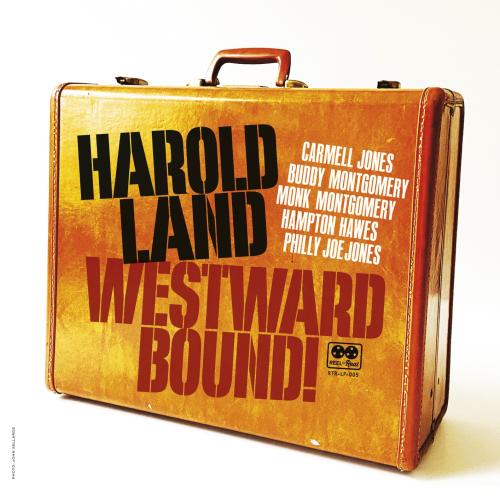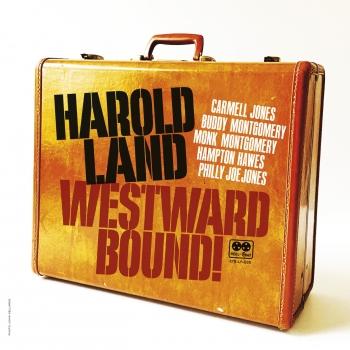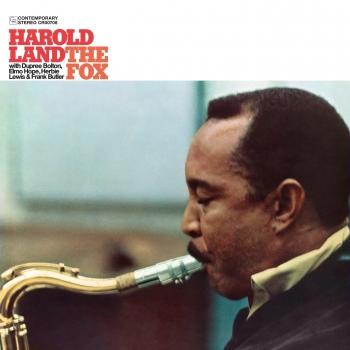
Westward Bound! (Live) Harold Land
Album info
Album-Release:
2021
HRA-Release:
06.08.2021
Album including Album cover
- 1 Vendetta (Live) 06:18
- 2 Beep Durple (Live) 09:20
- 3 Happily Dancing / Deep Harmonies Falling (Live) 08:38
- 4 My Romance (Live) 10:38
- 5 Triplin' the Groove (Live) 11:07
- 6 Autumn Leaves (Live) 11:27
- 7 Who Can I Turn To (Live) 04:54
- 8 Beau-Ty (Live) 07:09
- 9 Blue N' Boogie (Live) 02:47
Info for Westward Bound! (Live)
Contains previously un-issued live recordings of unsung tenor saxophone hero Harold Land from The Penthouse in Seattle from 1962, 1964 and 1965 with stellar musicians including Hampton Hawes, Carmell Jones, Buddy Montgomery and Philly Joe Jones.
Released in partnership with the Harold Land Estate, the remastered audio was captured from direct transfers of the original Penthouse's tape reels.
Continuing its mission to unearth important, previously unreleased jazz performances, Reel to Reel Recordings returns in June with Westward Bound!, a crucial collection of forceful quartet and quintet .performances by the masterful tenor saxophonist Harold Land
Crisply recorded at the Seattle jazz club the Penthouse in 1962-65 by engineer Jim Wilke and originally aired as part of a weekly broadcast from the venue on KING-FM, the new collection will be issued on June 12 as a 33-1/3 rpm two-LP set on 180-gram vinyl mastered by Kevin Gray of Coherent Audio and pressed by Standard Vinyl in Toronto. It will .be available on CD and digitally on July 16
Reel to Reel – a partnership between Vancouver-based jazz impresario and saxophonist Cory Weeds and Resonance Records co-president and award-winning “Jazz Detective” Zev Feldman – was launched in 2018 with a pair of releases that included its initial title drawn from the Penthouse’s audio trove, Cannonball Adderley’s Swingin’ in Seattle. The label has since issued Ow!, featuring 1962 Penthouse dates by tenor men Johnny Griffin and Eddie “Lockjaw” Davis; previous Resonance titles from the Penthouse archives have included sets by West Montgomery (Smokin’ in Seattle) and the Three Sounds featuring .Gene Harris (Groovin’ Hard)
In his notes to the new album, Feldman writes, ‘I feel that these recordings of Harold Land are special and need to be heard. Land was one of the purveyors of West Coast jazz whom I feel is an under- recognized genius who doesn’t get discussed enough....Land was on top of his game during this important part of his career in the mid- 1960s.” Comparing the new release to In Baltimore, Reel to Reel’s 2020 live collection by George Coleman, Weeds adds, “Westward Bound! finds us celebrating another unsung hero of the tenor ”.saxophone
Born in Houston and raised in San Diego, Harold Land established himself as a jazz star with four EmArcy albums in the tenor chair of trumpeter Clifford Brown and drummer Max Roach’s celebrated ‘50s quintet. Based in Los Angeles from the mid-‘50s on, he worked fruitfully as a leader, recorded regularly with big band leader-arranger Gerald Wilson, and played behind such giants as Dinah Washington, Wes Montgomery, Thelonious Monk, Les McCann, and Hampton Hawes. In later years he forged fruitful alliances with trumpeter Blue Mitchell, .vibraphonist Bobby Hutcherson, and the Timeless All Stars
Sonny Rollins – who replaced Land in the Brown-Roach combo – says in a new interview with Feldman, “Harold Land was one of the premier saxophonists of the time. He was one of the best....He was a great player, one of my favorites.” Contemporary tenor titan Joe Lovano tells Feldman, “Harold had his own sweet way of playing and his own”. flowing language....He was equal to Coltrane and Sonny
The earliest of the Penthouse dates heard on Westward Bound! pairs Land with a similarly underestimated player, the gifted Kansas City trumpeter Carmell Jones; the two musicians worked together regularly on sessions for Pacific Jazz Records. In his overview essay, jazz historian and producer Michael Cuscuna notes, “He and Land made a like-minded team; each would play every note with purpose and articulation.” The band on the Dec. 12, 1962 performance also included Wes Montgomery’s brothers Buddy (piano) and Monk (bass) .and drummer Jimmy Lovelace
During Penthouse gigs on Sept. 10 and 17, 1964, Land was joined by another prominent artist he had worked with before: pianist Hampton Hawes, who had led the storied 1958 quartet date For Real!, which also featured the saxophonist. In an essay about the keyboardists heard with Land on the new album, pianist Eric Reed says, “Although it is not widely acknowledged (or even known), Hamp was largely responsible for blending the language of the Blues, Jazz, and Gospel music in such ”.a way as to influence many that came after him Westward Bound! climaxes with an Aug. 5, 1965, date featuring Monk Montgomery, pianist John Houston, and another jazz legend, the explosive drummer Philly Joe Jones. The rhythm turbine of Miles Davis’ magnificent ‘50s quintet, Jones relocated in the ‘60s to L.A., where he played regularly with Land. Cuscuna writes, “This is a high- octane quartet, thanks in large part to Philly Joe’s ability to swing hard ”.and keep a tight rein on the music with the loosest feel.
In his own introductory note to the album, Charlie Puzzo, Jr., son of the Seattle club’s owner and operator, says, “I hope the release of this album will allow you to experience the magic of Harold Land’s performances at the Penthouse and also to feel the excitement of actually being in the audience. As a collector myself, I know how important it is that the packaging and esign live up to the source ”.material, and I believe this album does just that.
Harold Land, tenor saxophone
Carmell Jones, trumpet
Hampton Hawes, piano
John Houston, piano
Buddy Montgomery, piano
Monk Montgomery, bass
Philly Joe Jones, drums
Jimmy Lovelace, drums
Mel Lee, drums
Digitally remastered
Harold Land
A soft-spoken man whose personality rarely suggests the incandescence of his instrumental sound, Harold Land was born in 1928 in Houston, Texas. The family moved to San diego when he was five; it was during his high school years there he became interested in music and in 1945 was presented with his first saxophone.
His early influences were the big, warm tones of Coleman Hawkins and Lucky Thompson; later Charlie Parker's new concepts helped determine his direction. He was just out of high school when a bass player named Ralph Houston helped him join the Musician's Union.
After working in Houston's band, he spent a long while soaking up experience at the Creole Palace where a small combo, usually five or six pieces, was led by Froebel Brigham, a trumpeter. "During both these jobs my closest friend and musical colleage was the drummer, Leon Petties," Harold remembers. "We played the floor show and jazz sets too. Sometimes men like Hampton Hawes, Teddy Edwards and Sonny Criss came down from Los Angeles and worked with us--this provided a great stimulus."
Later, Land and Petties went on the road for about a year, first with a group led by guitarist Jimmy Liggins, and then in the band of his celebrated brother, Joe "Honeydripper" Liggins. Harold recalls this rhythm-and-blues experience as valuable in rounding out his musical education. After putting in additional time back at the Creole Palace, Harold decided in 1954 to try his luck in Los Angeles. For several months there were various odd jobs, none very rewarding.
The turning point came one night when Clifford Brown took his combo-leading partner, Max Roach to hear Harold play in a session at Eric Dolphy's house. "Eric had known me since the San Diego days, and after I moved to L.A. we became good friends," Harold says. "He was beautiful. Eric loved to play anywhere, any hour of the day or night. So did I. In fact, I still do."
The unofficial audition led to Harold's being hired by Brown and Roach. As jazz night club audiences around the country were exposed to the freshness and vitality of Land's playing, he seemed to be well on his way; but in 1956 he had to leave the quintet and return to Los Angeles because of illness in the family.
If, during the balance of the 1950s, he had continued to tour with name groups, there is little doubt that his reputation would have been established sooner and much more firmly on an international level.
"Harold's been one of the finest tenor players I've heard and I have hardly heard a write-up about what this man has been doing through the years. In New York he would have gotten more." (Buddy Collette) Source: LEONARD FEATHER, from the liner notes, The Fox, 1959, Contemporary.
This album contains no booklet.











